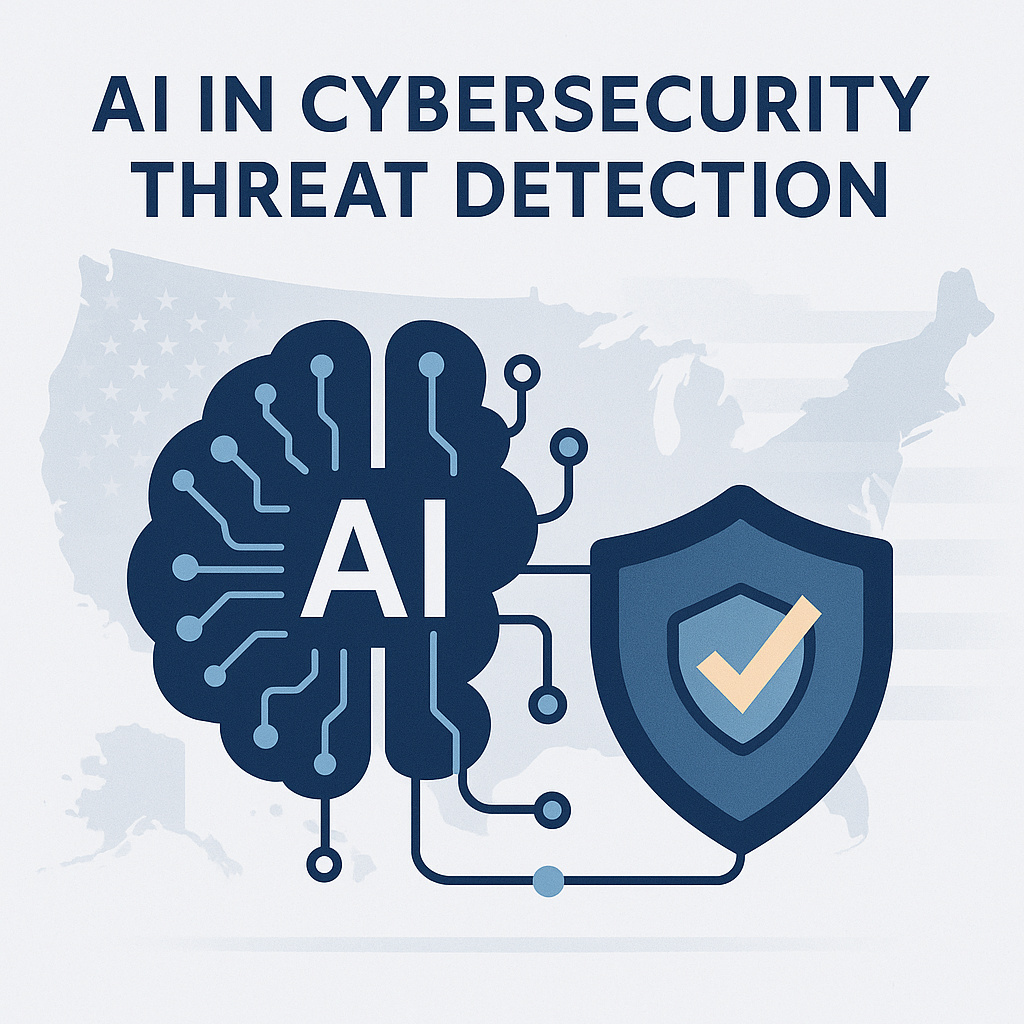
AI in Cybersecurity Threat Detection: The 2025 Guide for U.S. Businesses
In 2025, the landscape of digital threats is more complex than ever. As cybercriminals evolve, so must our defenses. One of the most transformative advancements in this field is AI in cybersecurity threat detection. This comprehensive guide explores how artificial intelligence is revolutionizing threat detection, the top AI-powered solutions, and actionable strategies for U.S. organizations.
Understanding AI in Cybersecurity Threat Detection
Artificial Intelligence (AI) is no longer a futuristic concept—it’s a critical tool in the fight against cyber threats. By leveraging machine learning, deep learning, and advanced analytics, AI systems can identify, analyze, and respond to threats faster and more accurately than traditional methods.
What Is AI-Powered Threat Detection?
AI-powered threat detection refers to the use of algorithms and data-driven models to:
- 🏥 Monitor network traffic and user behavior
- 📦 Detect anomalies and suspicious patterns
- ✅ Automate incident response and mitigation
TIP: AI systems can process vast amounts of data in real-time, making them ideal for identifying zero-day attacks and advanced persistent threats (APTs).
Why U.S. Organizations Need AI in Cybersecurity Threat Detection
The U.S. faces a growing number of cyberattacks, from ransomware to phishing and insider threats. According to the latest 2025 data, the average cost of a data breach in the U.S. has reached $9.8 million, making robust threat detection essential.
Key Benefits for U.S. Businesses
- Speed: AI detects threats in milliseconds, reducing response times.
- Accuracy: Machine learning models minimize false positives.
- Scalability: AI adapts to growing networks and evolving threats.
- Proactive Defense: Predicts and prevents attacks before they occur.
Top 10 AI-Powered Cybersecurity Threat Detection Tools in 2025
Choosing the right AI solution can be overwhelming. Here’s a ranked list of the top 10 AI-powered cybersecurity threat detection tools for U.S. organizations in 2025, along with a comparison table for quick reference.
1. CrowdStrike Falcon
2. Darktrace Enterprise Immune System
3. IBM QRadar Advisor with Watson
4. Palo Alto Networks Cortex XDR
5. Microsoft Defender for Endpoint
6. SentinelOne Singularity
7. Vectra AI Cognito
8. FireEye Helix
9. Splunk Security Cloud
10. Cisco SecureX
Side-by-Side Comparison Table
| Rank | Solution Name | AI Capabilities | Best For | U.S. Market Focus | Price Tier |
|---|---|---|---|---|---|
| 1 | CrowdStrike Falcon | ML, Behavioral AI | Endpoint Security | Enterprise/SMB | $$$ |
| 2 | Darktrace Enterprise Immune Sys | Self-learning AI | Network Threat Detection | Enterprise | $$$$ |
| 3 | IBM QRadar Advisor with Watson | NLP, Cognitive AI | SIEM Integration | Enterprise | $$$$ |
| 4 | Palo Alto Cortex XDR | ML, Analytics | Extended Detection | Enterprise | $$$ |
| 5 | Microsoft Defender for Endpoint | Cloud AI, Automation | Windows Environments | SMB/Enterprise | $$ |
| 6 | SentinelOne Singularity | Autonomous AI | Endpoint & Cloud | SMB/Enterprise | $$$ |
| 7 | Vectra AI Cognito | Network AI | Lateral Movement Detection | Enterprise | $$$$ |
| 8 | FireEye Helix | ML, Threat Intel | Managed Detection | Enterprise | $$$$ |
| 9 | Splunk Security Cloud | Analytics, ML | Data-Driven Security | Enterprise | $$$$ |
| 10 | Cisco SecureX | Integrated AI | Unified Security | SMB/Enterprise | $$ |
TIP: When selecting a solution, consider your organization’s size, industry, and regulatory requirements.
How AI Detects Cybersecurity Threats: Key Techniques
AI systems use a variety of techniques to identify and neutralize threats:
1. Machine Learning (ML) Algorithms
ML models learn from historical data to recognize normal and abnormal behavior. For example:
if network_traffic > baseline_traffic and user_behavior == "anomalous":
alert("Potential Threat Detected")
2. Deep Learning for Pattern Recognition
Deep learning models analyze complex data sets, such as images or logs, to detect subtle indicators of compromise.
3. Natural Language Processing (NLP)
NLP helps AI systems understand and analyze phishing emails, malicious documents, and social engineering attempts.
4. Behavioral Analytics
AI monitors user and device behavior to spot deviations that may indicate insider threats or compromised accounts.
Real-World Use Cases of AI in Cybersecurity Threat Detection
Financial Services
Banks use AI to detect fraudulent transactions and prevent account takeovers in real-time.
Healthcare
Hospitals deploy AI to safeguard patient data and comply with HIPAA regulations.
Government
Federal agencies leverage AI to protect critical infrastructure from nation-state actors.
TIP: AI-driven threat detection is especially effective in industries with strict compliance requirements.
Challenges and Considerations for AI in Cybersecurity Threat Detection
While AI offers significant advantages, it’s not without challenges:
- Data Privacy: AI systems require access to large volumes of sensitive data.
- False Positives: Poorly trained models may generate unnecessary alerts.
- Skill Gaps: Implementing AI solutions requires specialized expertise.
- Adversarial Attacks: Cybercriminals may attempt to deceive AI models.
TIP: Regularly update and retrain AI models to maintain effectiveness against evolving threats.
Best Practices for Implementing AI in Cybersecurity Threat Detection
- Assess Your Needs: Identify your organization’s unique threat landscape.
- Choose the Right Tools: Select AI solutions that align with your infrastructure.
- Integrate with Existing Systems: Ensure seamless interoperability.
- Train Your Team: Upskill staff to manage and interpret AI-driven alerts.
- Monitor and Optimize: Continuously evaluate AI performance and adjust as needed.
Conclusion
AI in cybersecurity threat detection is a game-changer for U.S. organizations in 2025. By leveraging advanced algorithms, machine learning, and real-time analytics, AI empowers businesses to detect and respond to threats faster and more accurately than ever before. The top AI-powered tools offer a range of capabilities tailored to different industries and needs, but successful implementation requires careful planning, skilled personnel, and ongoing optimization.
As cyber threats continue to evolve, integrating AI into your cybersecurity strategy is no longer optional—it’s essential for protecting your data, reputation, and bottom line. Embrace AI-driven threat detection today to stay ahead of tomorrow’s cyber adversaries.